Objective function: ebnm_pn vs. ebnm_ash
Jason Willwerscheid
7/14/2018
Last updated: 2018-07-20
workflowr checks: (Click a bullet for more information)-
✔ R Markdown file: up-to-date
Great! Since the R Markdown file has been committed to the Git repository, you know the exact version of the code that produced these results.
-
✔ Environment: empty
Great job! The global environment was empty. Objects defined in the global environment can affect the analysis in your R Markdown file in unknown ways. For reproduciblity it’s best to always run the code in an empty environment.
-
✔ Seed:
set.seed(20180714)The command
set.seed(20180714)was run prior to running the code in the R Markdown file. Setting a seed ensures that any results that rely on randomness, e.g. subsampling or permutations, are reproducible. -
✔ Session information: recorded
Great job! Recording the operating system, R version, and package versions is critical for reproducibility.
-
Great! You are using Git for version control. Tracking code development and connecting the code version to the results is critical for reproducibility. The version displayed above was the version of the Git repository at the time these results were generated.✔ Repository version: 2761284
Note that you need to be careful to ensure that all relevant files for the analysis have been committed to Git prior to generating the results (you can usewflow_publishorwflow_git_commit). workflowr only checks the R Markdown file, but you know if there are other scripts or data files that it depends on. Below is the status of the Git repository when the results were generated:
Note that any generated files, e.g. HTML, png, CSS, etc., are not included in this status report because it is ok for generated content to have uncommitted changes.Ignored files: Ignored: .DS_Store Ignored: .Rhistory Ignored: .Rproj.user/ Ignored: docs/.DS_Store Ignored: docs/figure/.DS_Store Unstaged changes: Modified: analysis/flash_em.Rmd Modified: analysis/index.Rmd Modified: analysis/obj_notes.Rmd
Expand here to see past versions:
| File | Version | Author | Date | Message |
|---|---|---|---|---|
| Rmd | 2761284 | Jason Willwerscheid | 2018-07-20 | wflow_publish(c(“analysis/objective3.Rmd”, |
| html | 1c31f1b | Jason Willwerscheid | 2018-07-20 | Build site. |
| Rmd | d1a6b4f | Jason Willwerscheid | 2018-07-20 | wflow_publish(c(“analysis/objective.Rmd”, |
| html | 7db12a1 | Jason Willwerscheid | 2018-07-16 | Build site. |
| html | 873da40 | Jason Willwerscheid | 2018-07-16 | Build site. |
| Rmd | b0dbc3a | Jason Willwerscheid | 2018-07-16 | add Rdata for variables before ‘bad’ update |
| html | 019bf35 | Jason Willwerscheid | 2018-07-15 | Build site. |
| Rmd | a19a4a0 | Jason Willwerscheid | 2018-07-15 | wflow_publish(“analysis/objective2.Rmd”) |
| Rmd | 67360f4 | Jason Willwerscheid | 2018-07-15 | manual objective2 commit |
| html | 67360f4 | Jason Willwerscheid | 2018-07-15 | manual objective2 commit |
Introduction
Here I use ebnm_ash to see if I obtain similar decreases in the objective function as were obtained in the previous investigation.
Fits
I use the same dataset as in the previous investigation.
# devtools::install_github("stephenslab/flashr", ref="trackObj")
devtools::load_all("/Users/willwerscheid/GitHub/flashr")Loading flashr# devtools::install_github("stephenslab/ebnm")
devtools::load_all("/Users/willwerscheid/GitHub/ebnm")Loading ebnmgtex <- readRDS(gzcon(url("https://github.com/stephenslab/gtexresults/blob/master/data/MatrixEQTLSumStats.Portable.Z.rds?raw=TRUE")))
strong <- gtex$strong.zI fit four factors greedily using both ebnm_pn and ebnm_ash.
pn_res <- flash_add_greedy(strong, Kmax=4, verbose=FALSE)fitting factor/loading 1fitting factor/loading 2fitting factor/loading 3fitting factor/loading 4ash_res <- flash_add_greedy(strong, Kmax=4, ebnm_fn = "ebnm_ash",
verbose=FALSE)fitting factor/loading 1fitting factor/loading 2fitting factor/loading 3fitting factor/loading 4plot_obj <- function(res, k, niters) {
obj_data <- as.vector(rbind(res$obj[[k]]$after_tau,
res$obj[[k]]$after_f,
res$obj[[k]]$after_l))
max_obj <- max(obj_data)
obj_data <- obj_data - max_obj
iter <- 1:length(obj_data) / 3
if (length(obj_data) > niters*3) {
idx <- (length(obj_data) - niters*3 + 1):length(obj_data)
obj_data <- obj_data[idx]
iter <- iter[idx]
}
plt_xlab <- "Iteration"
plt_ylab <- "Diff. from maximum obj."
plt_colors <- c("indianred1", "indianred3", "indianred4")
plt_pch <- c(16, 17, 15)
main <- paste("Factor/loading", k)
plot(iter, obj_data, col=plt_colors, pch=plt_pch,
xlab=plt_xlab, ylab=plt_ylab, main=main)
legend("bottomright", c("after tau", "after f", "after l"),
col=plt_colors, pch=plt_pch)
}Results: ebnm_pn
The problem discussed in the previous investigation occurs every time.
plot_obj(pn_res, 1, niters=3)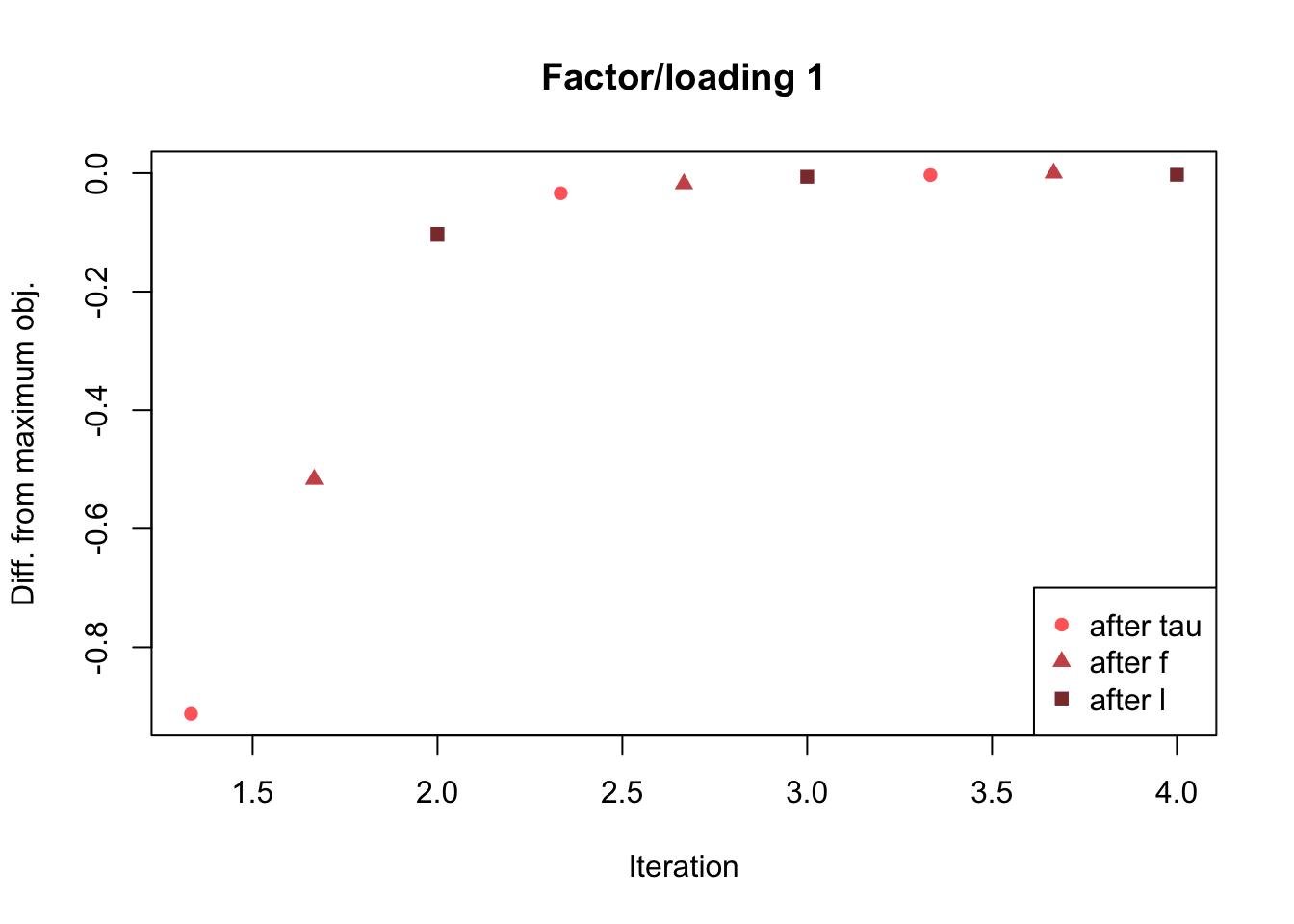
Expand here to see past versions of plot_pn-1.png:
| Version | Author | Date |
|---|---|---|
| 1c31f1b | Jason Willwerscheid | 2018-07-20 |
| 873da40 | Jason Willwerscheid | 2018-07-16 |
| 019bf35 | Jason Willwerscheid | 2018-07-15 |
plot_obj(pn_res, 2, niters=5)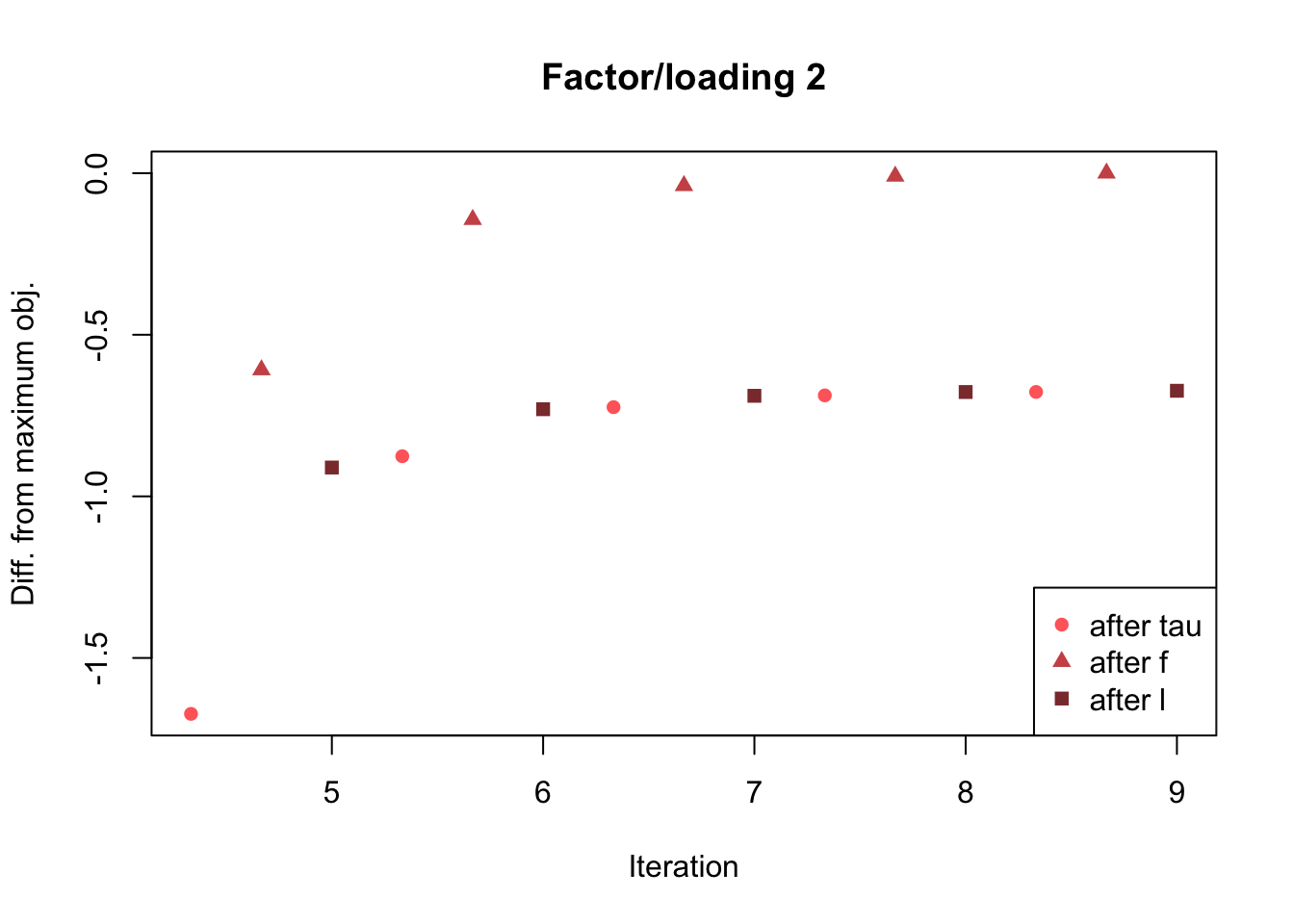
Expand here to see past versions of plot_pn-2.png:
| Version | Author | Date |
|---|---|---|
| 1c31f1b | Jason Willwerscheid | 2018-07-20 |
| 873da40 | Jason Willwerscheid | 2018-07-16 |
| 019bf35 | Jason Willwerscheid | 2018-07-15 |
plot_obj(pn_res, 3, niters=20)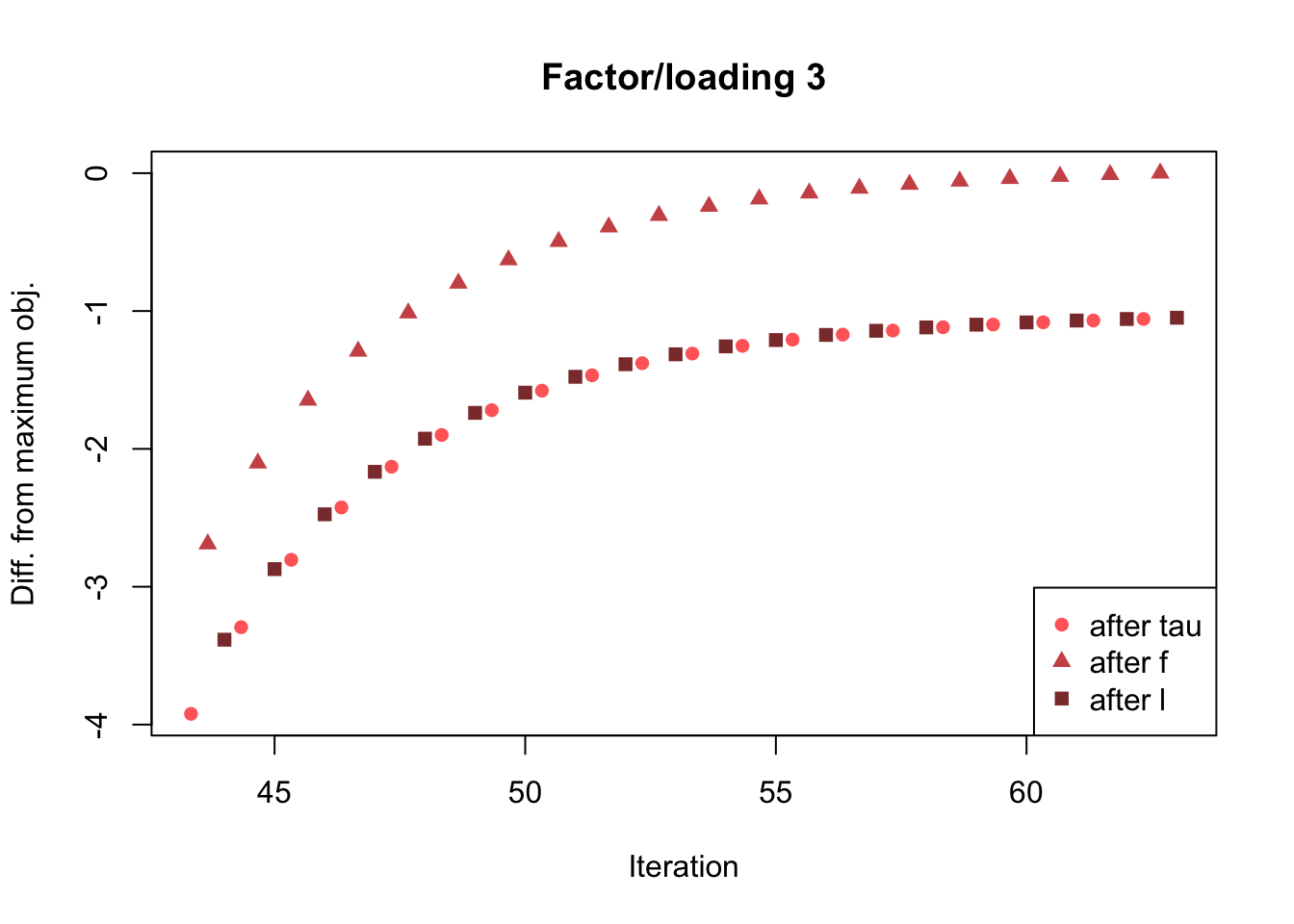
Expand here to see past versions of plot_pn-3.png:
| Version | Author | Date |
|---|---|---|
| 1c31f1b | Jason Willwerscheid | 2018-07-20 |
| 873da40 | Jason Willwerscheid | 2018-07-16 |
| 019bf35 | Jason Willwerscheid | 2018-07-15 |
plot_obj(pn_res, 4, niters=10)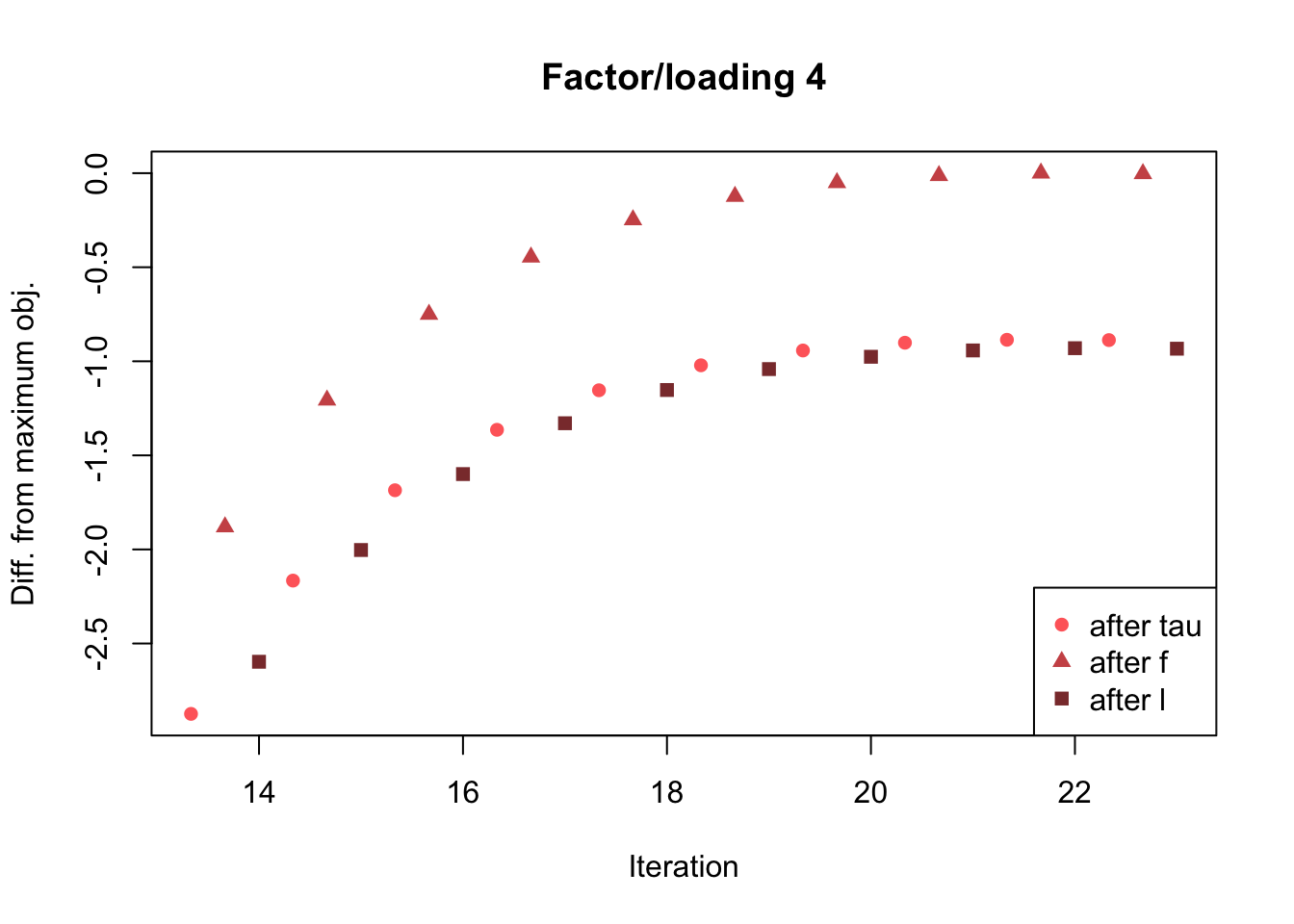
Results: ebnm_ash
But no obvious problems occur when using ebnm_ash.
plot_obj(ash_res, 1, niters=3)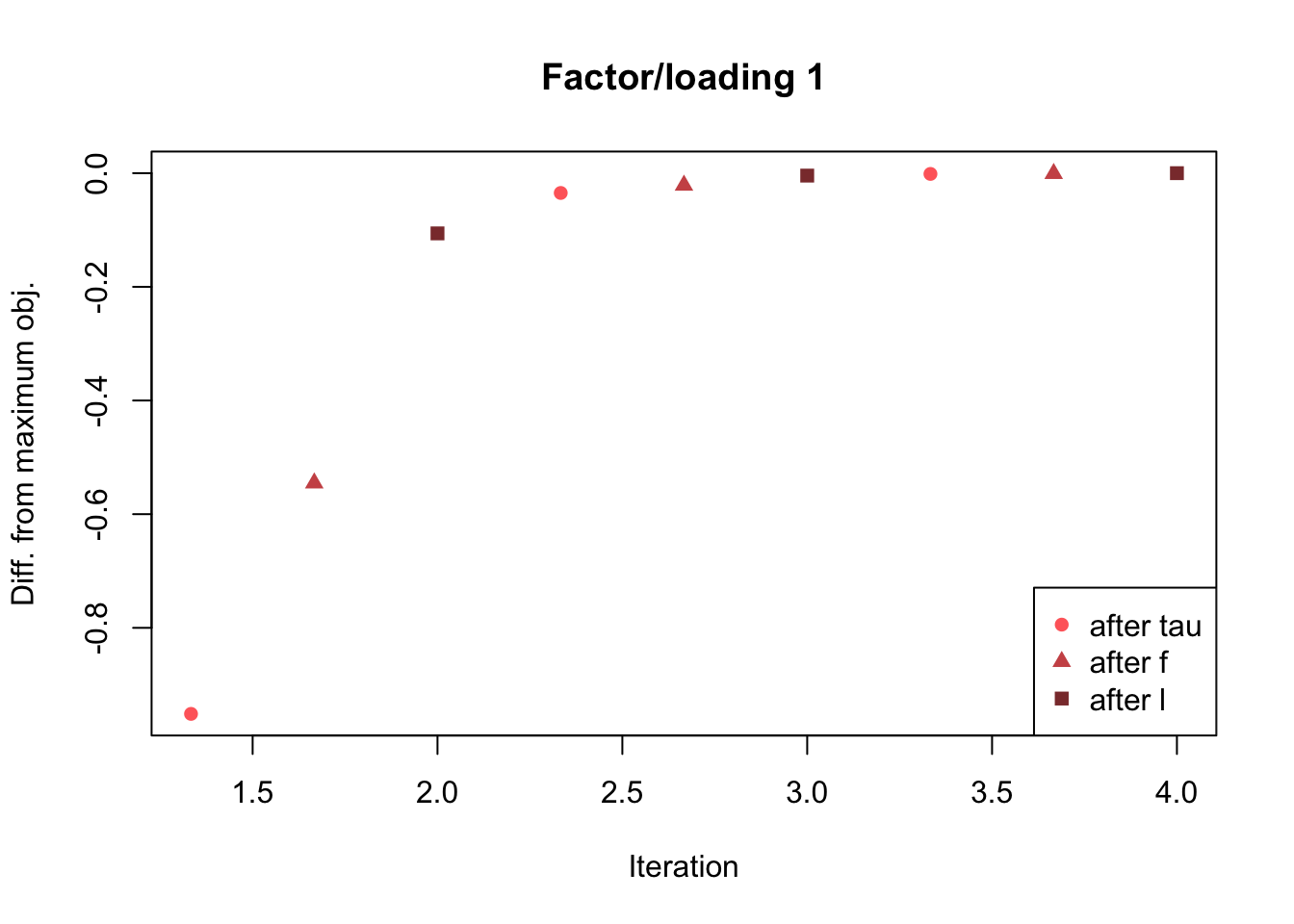
Expand here to see past versions of plot_ash-1.png:
| Version | Author | Date |
|---|---|---|
| 1c31f1b | Jason Willwerscheid | 2018-07-20 |
| 019bf35 | Jason Willwerscheid | 2018-07-15 |
plot_obj(ash_res, 2, niters=5)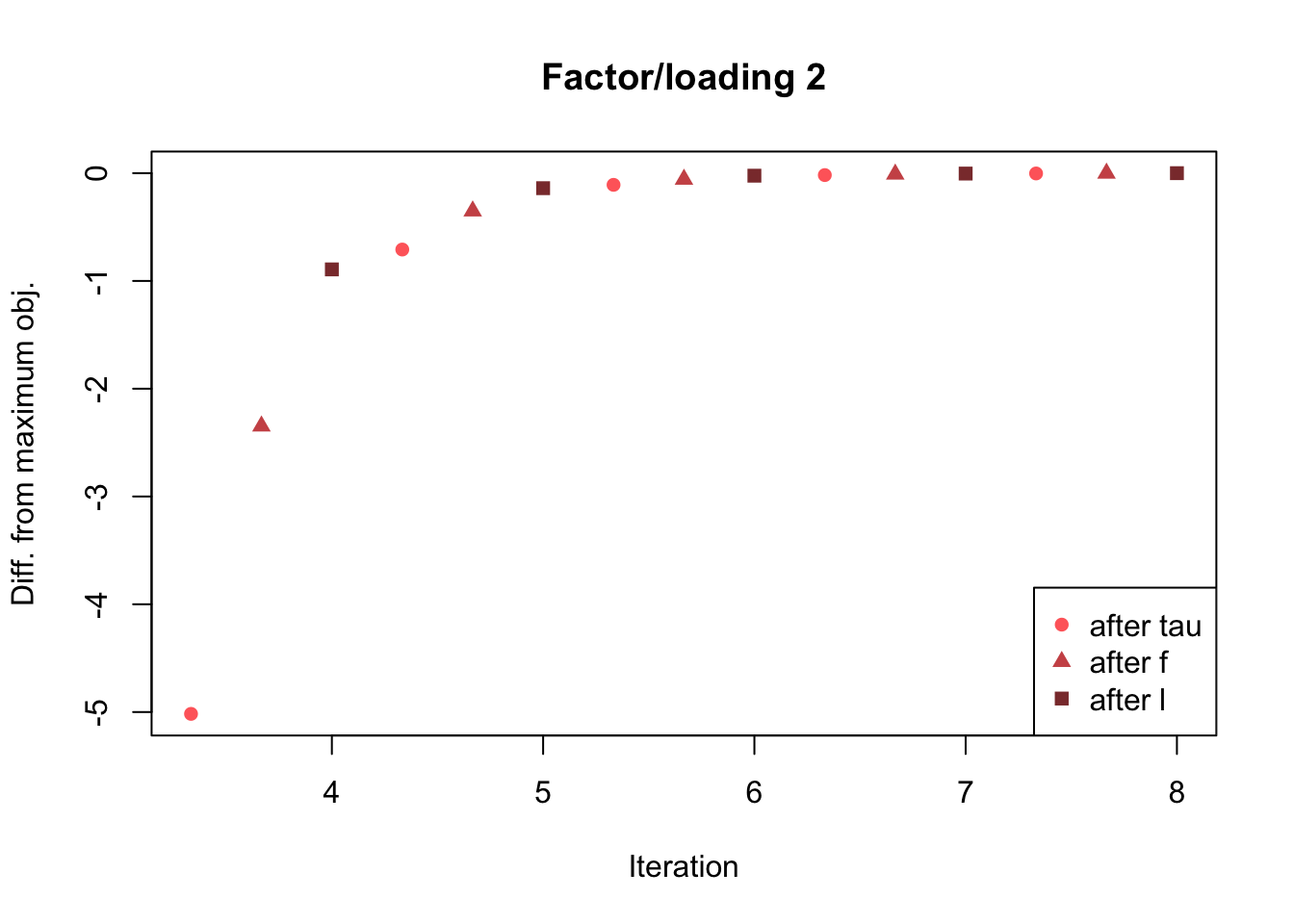
Expand here to see past versions of plot_ash-2.png:
| Version | Author | Date |
|---|---|---|
| 1c31f1b | Jason Willwerscheid | 2018-07-20 |
| 019bf35 | Jason Willwerscheid | 2018-07-15 |
plot_obj(ash_res, 3, niters=10)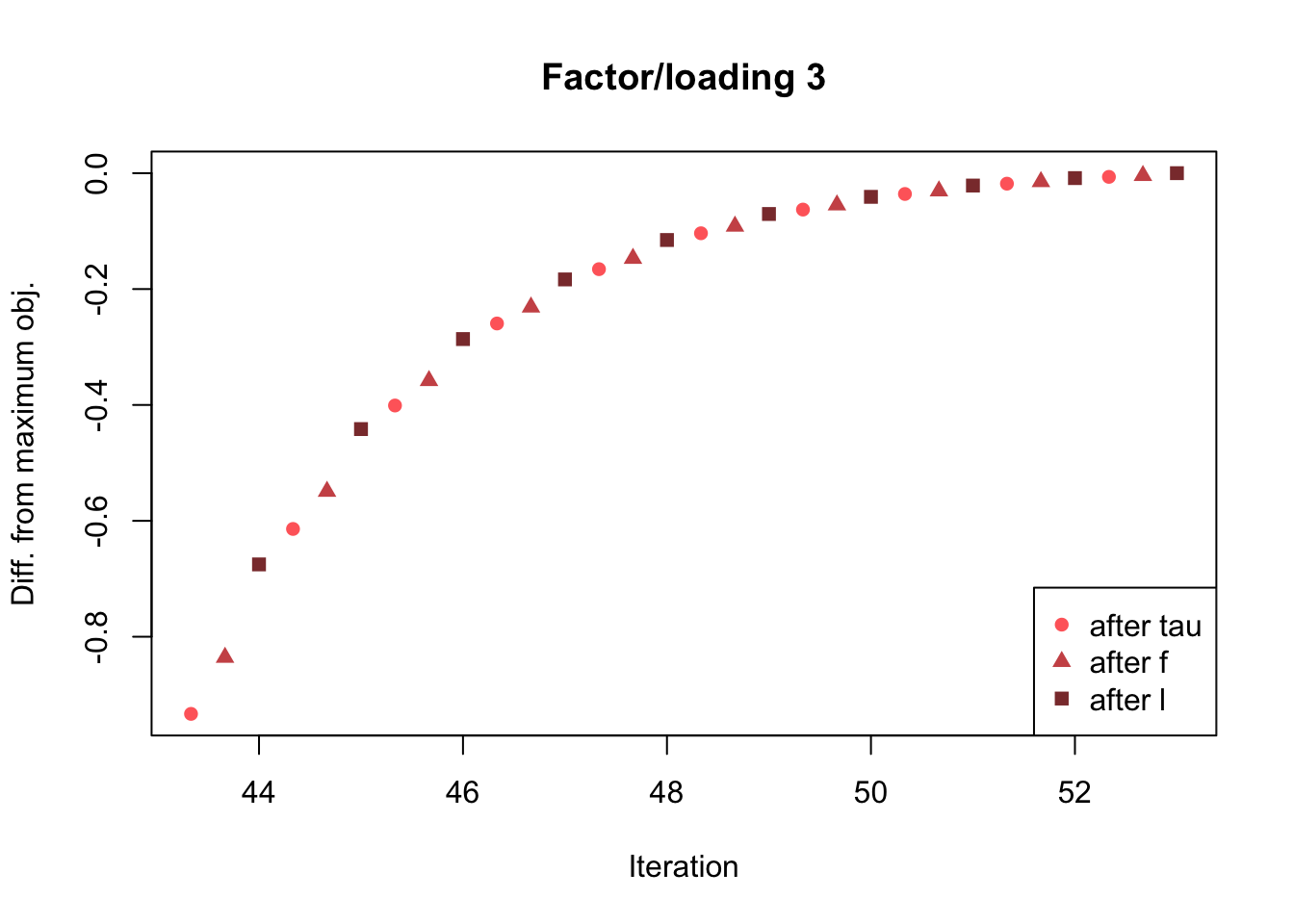
Expand here to see past versions of plot_ash-3.png:
| Version | Author | Date |
|---|---|---|
| 1c31f1b | Jason Willwerscheid | 2018-07-20 |
| 019bf35 | Jason Willwerscheid | 2018-07-15 |
plot_obj(ash_res, 4, niters=20)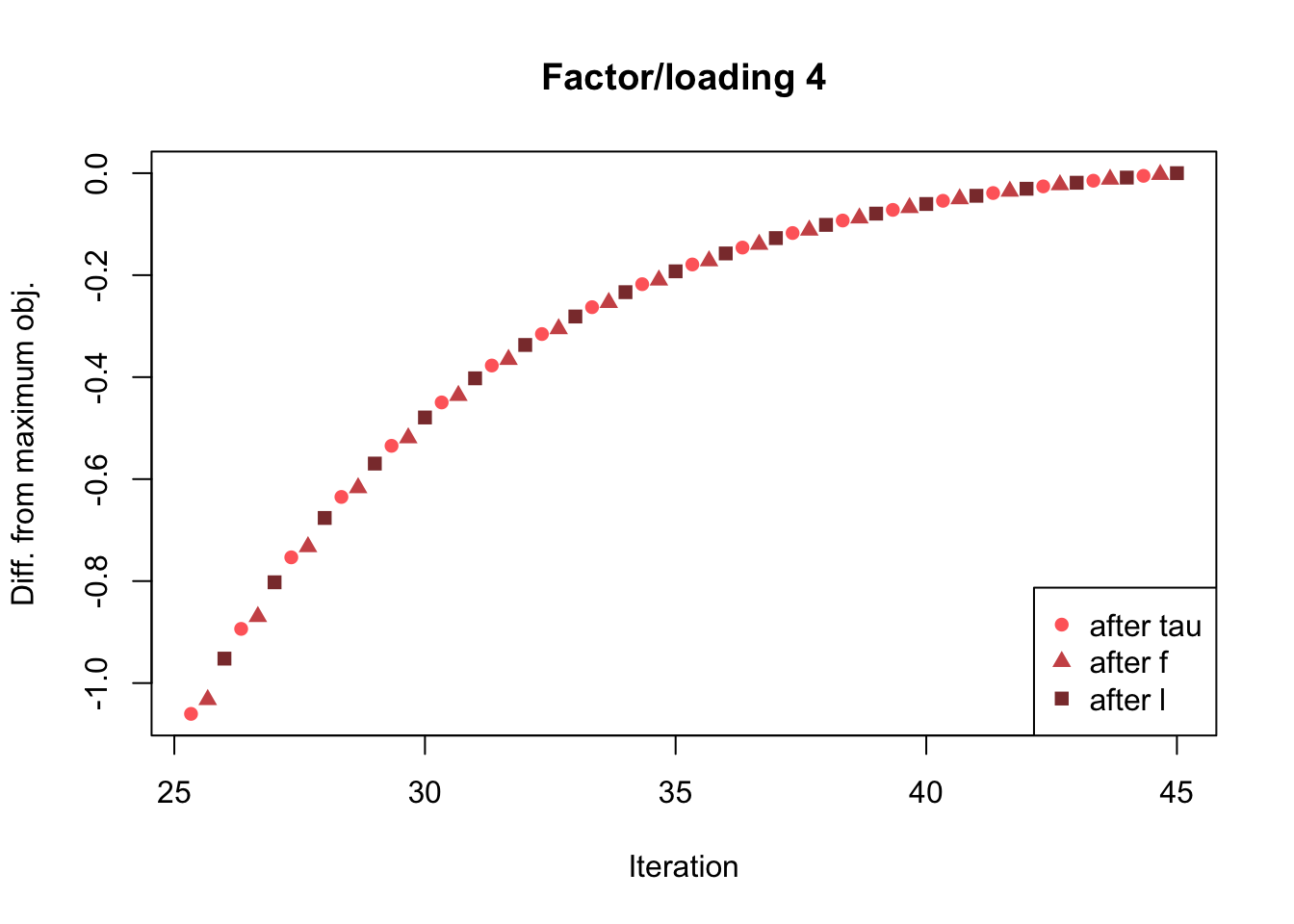
Conclusions
When using ebnm_ash, the objective does not suffer from the same erratic behavior as when using ebnm_pn. Is there a weird bug somewhere in the computation of the likelihood function for ebnm_pn?
Session information
sessionInfo()R version 3.4.3 (2017-11-30)
Platform: x86_64-apple-darwin15.6.0 (64-bit)
Running under: macOS Sierra 10.12.6
Matrix products: default
BLAS: /Library/Frameworks/R.framework/Versions/3.4/Resources/lib/libRblas.0.dylib
LAPACK: /Library/Frameworks/R.framework/Versions/3.4/Resources/lib/libRlapack.dylib
locale:
[1] en_US.UTF-8/en_US.UTF-8/en_US.UTF-8/C/en_US.UTF-8/en_US.UTF-8
attached base packages:
[1] stats graphics grDevices utils datasets methods base
other attached packages:
[1] ebnm_0.1-12 flashr_0.5-12
loaded via a namespace (and not attached):
[1] Rcpp_0.12.17 pillar_1.2.1 plyr_1.8.4
[4] compiler_3.4.3 git2r_0.21.0 workflowr_1.0.1
[7] R.methodsS3_1.7.1 R.utils_2.6.0 iterators_1.0.9
[10] tools_3.4.3 testthat_2.0.0 digest_0.6.15
[13] tibble_1.4.2 evaluate_0.10.1 memoise_1.1.0
[16] gtable_0.2.0 lattice_0.20-35 rlang_0.2.0
[19] Matrix_1.2-12 foreach_1.4.4 commonmark_1.4
[22] yaml_2.1.17 parallel_3.4.3 withr_2.1.1.9000
[25] stringr_1.3.0 roxygen2_6.0.1.9000 xml2_1.2.0
[28] knitr_1.20 REBayes_1.2 devtools_1.13.4
[31] rprojroot_1.3-2 grid_3.4.3 R6_2.2.2
[34] rmarkdown_1.8 ggplot2_2.2.1 ashr_2.2-10
[37] magrittr_1.5 whisker_0.3-2 backports_1.1.2
[40] scales_0.5.0 codetools_0.2-15 htmltools_0.3.6
[43] MASS_7.3-48 assertthat_0.2.0 softImpute_1.4
[46] colorspace_1.3-2 stringi_1.1.6 Rmosek_7.1.3
[49] lazyeval_0.2.1 munsell_0.4.3 doParallel_1.0.11
[52] pscl_1.5.2 truncnorm_1.0-8 SQUAREM_2017.10-1
[55] R.oo_1.21.0 This reproducible R Markdown analysis was created with workflowr 1.0.1